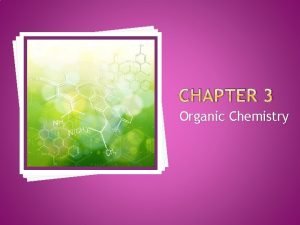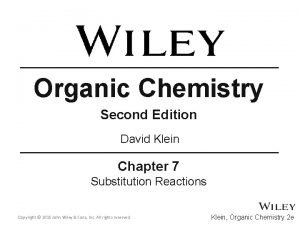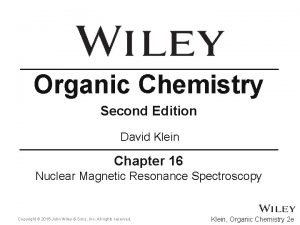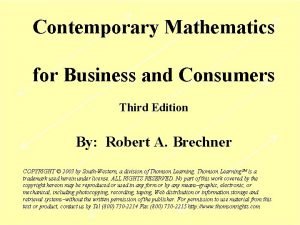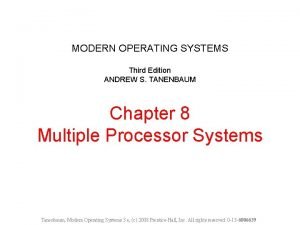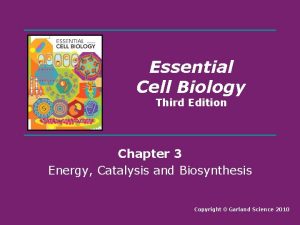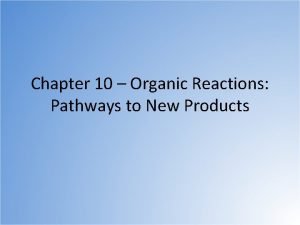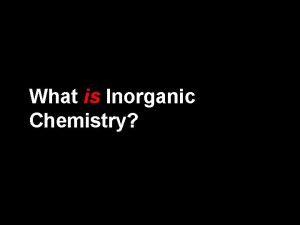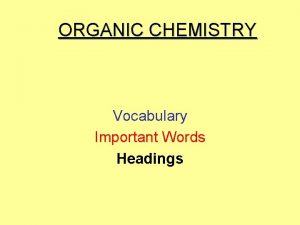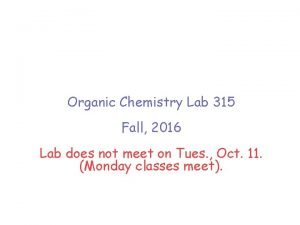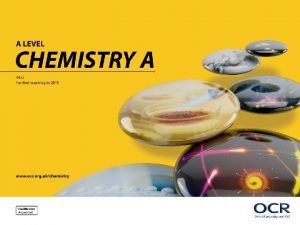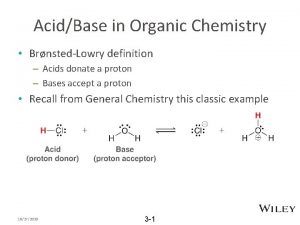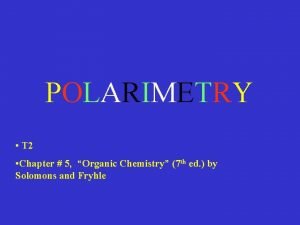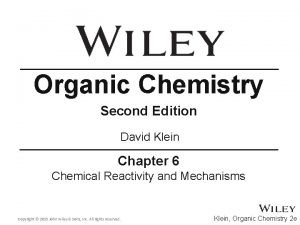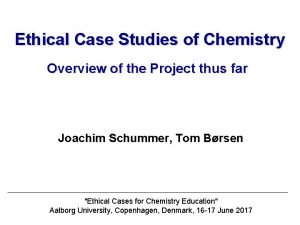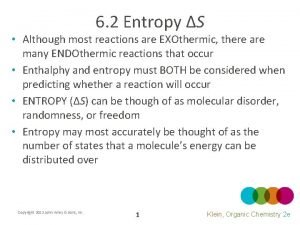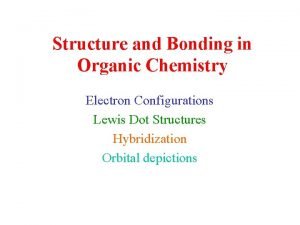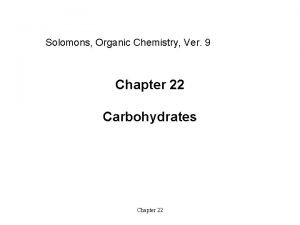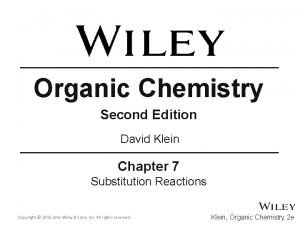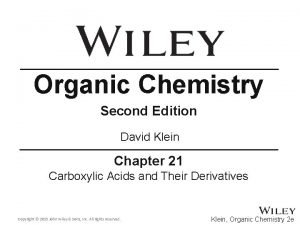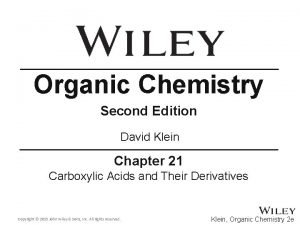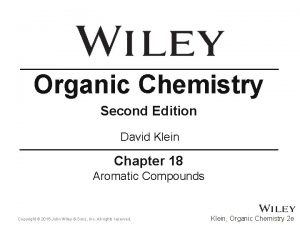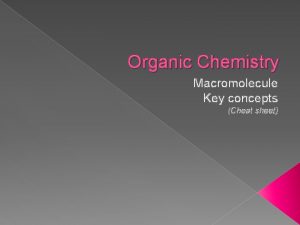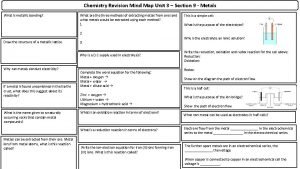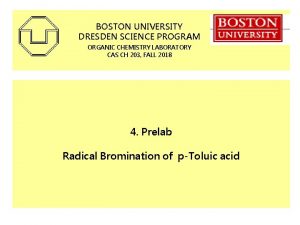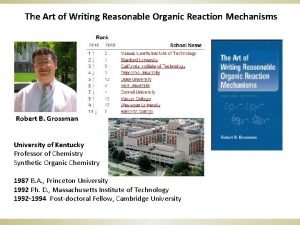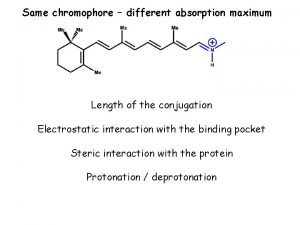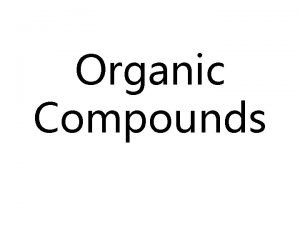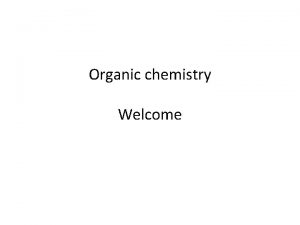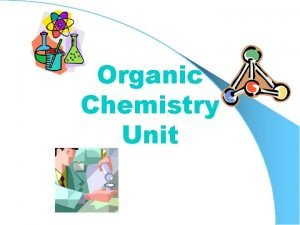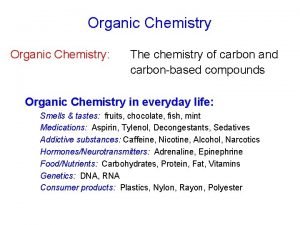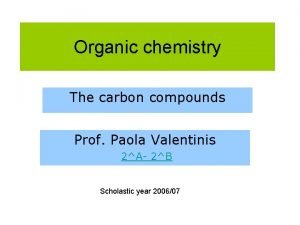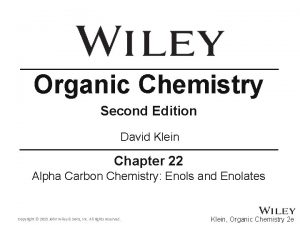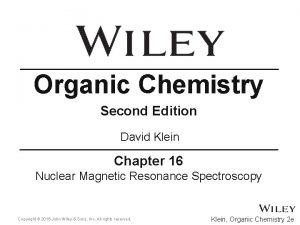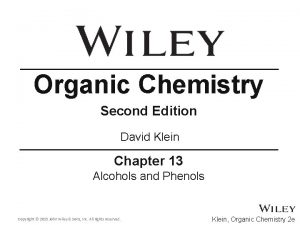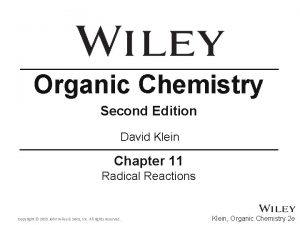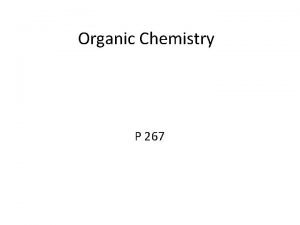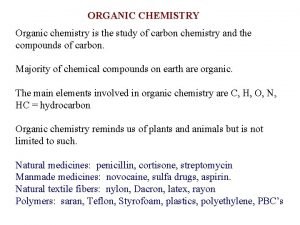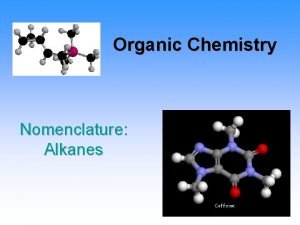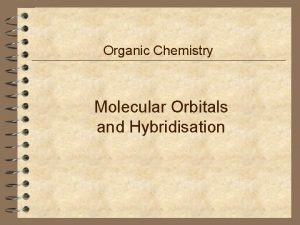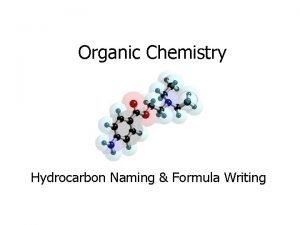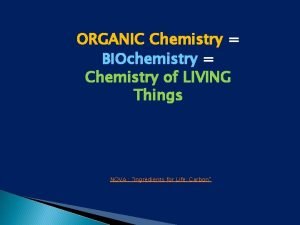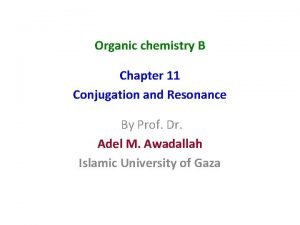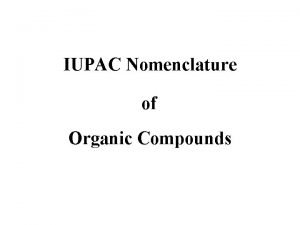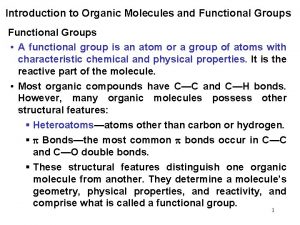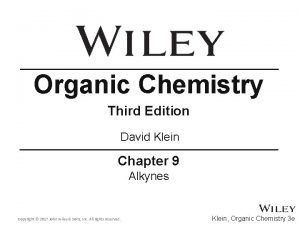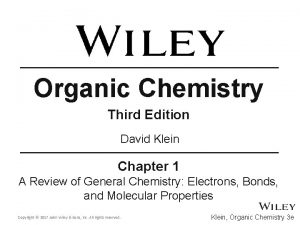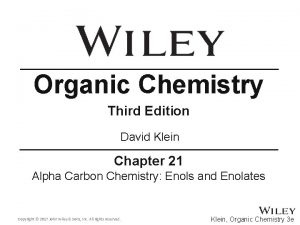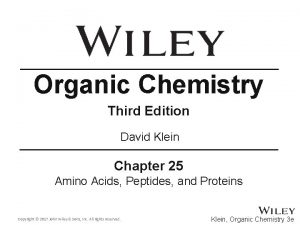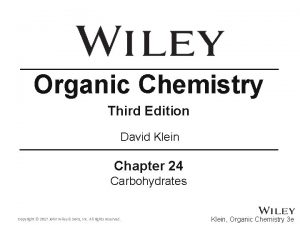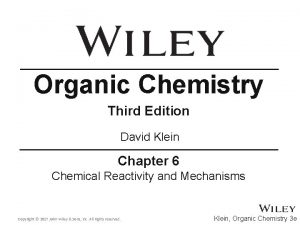Organic Chemistry Third Edition David Klein Chapter 8

































































































- Slides: 97

Organic Chemistry Third Edition David Klein Chapter 8 Addition Reactions and Alkenes Copyright © 2017 John Wiley & Sons, Inc. All rights reserved. Klein, Organic Chemistry 3 e

8. 1 Introduction to Addition Reactions C=C p bond is converted to two new sigma bonds Addition is the opposite of elimination Copyright © 2017 John Wiley & Sons, Inc. All rights reserved. 8 -2 Klein, Organic Chemistry 3 e

8. 1 Introduction to Addition Reactions • The p bond is an electron-pair donor Copyright © 2017 John Wiley & Sons, Inc. All rights reserved. 8 -3 Klein, Organic Chemistry 3 e

8. 2 Alkenes in Nature and Industry • Naturally occurring, acyclic alkenes: Copyright © 2017 John Wiley & Sons, Inc. All rights reserved. 8 -4 Klein, Organic Chemistry 3 e

8. 2 Alkenes in Nature and Industry • Cyclic and polycyclic alkenes: Copyright © 2017 John Wiley & Sons, Inc. All rights reserved. 8 -5 Klein, Organic Chemistry 3 e

8. 2 Alkenes in Nature and Industry • C=C double bonds often found in the structures of pheromones Copyright © 2017 John Wiley & Sons, Inc. All rights reserved. 8 -6 Klein, Organic Chemistry 3 e

8. 2 Alkenes in Nature and Industry • Alkenes are critical precursors in the chemical industry • 70 billion pounds of propylene (propene) and 200 billion pounds of ethylene (ethene) are both made from cracking petroleum each year Copyright © 2017 John Wiley & Sons, Inc. All rights reserved. 8 -7 Klein, Organic Chemistry 3 e

8. 2 Alkenes in Nature and Industry Copyright © 2017 John Wiley & Sons, Inc. All rights reserved. 8 -8 Klein, Organic Chemistry 3 e

8. 3 Addition vs. Elimination • Addition and elimination are equilibrating reactions: – Which side is favored depends on temperature – The higher the temperature, the more important entropy becomes: Higher temp means a bigger entropy term Copyright © 2017 John Wiley & Sons, Inc. All rights reserved. 8 -9 Klein, Organic Chemistry 3 e

8. 3 Addition vs. Elimination • Addition reactions are favored by enthalpy. • Sigma bonds are stronger (more stable) than p bonds DH = Bonds broken – bonds formed DH = 166 kcal/mol – 185 kcal/mol DH = – 19 kcal/mol Copyright © 2017 John Wiley & Sons, Inc. All rights reserved. 8 -10 Klein, Organic Chemistry 3 e

8. 3 Addition vs. Elimination • Addition reactions are NOT favored by entropy. • Two molecules combine to form one product; entropy decreases ONE product TWO reactants Copyright © 2017 John Wiley & Sons, Inc. All rights reserved. 8 -11 Klein, Organic Chemistry 3 e

8. 3 Addition vs. Elimination • At lower temps, enthalpy dominates, and addition reactions are favored • At higher temps, entropy dominates, and elimination reactions are favored • So, we use lower temperatures when doing an addition reaction Copyright © 2017 John Wiley & Sons, Inc. All rights reserved. 8 -12 Klein, Organic Chemistry 3 e

8. 4 Hydrohalogenation • Hydrohalogenation: addition of H-X to an alkene • can use HCl, HBr, or HI • If the alkene is not symmetrical, then two regioisomers are possible, depending on which carbon gets the “H” and the “X” Copyright © 2017 John Wiley & Sons, Inc. All rights reserved. 8 -13 Klein, Organic Chemistry 3 e

8. 4 Hydrohalogenation - Regioselectivity • Hydrohalogenation is regioselective for Markovnikov addition • In 1869, Markovnikov observed the H atoms tend to add to the carbon already bearing more H atoms • The halogen is generally installed at the more substituted carbon Copyright © 2017 John Wiley & Sons, Inc. All rights reserved. 8 -14 Klein, Organic Chemistry 3 e

8. 4 Hydrohalogenation - Regioselectivity • When peroxides are used with HBr, the opposite regioselectivity is observed. • The reaction mechanism must be different, when peroxides are present. Copyright © 2017 John Wiley & Sons, Inc. All rights reserved. 8 -15 Klein, Organic Chemistry 3 e

8. 4 Hydrohalogenation - Regioselectivity • The important lesson here is that the regioselectivity of HBr addition can be controlled: Copyright © 2017 John Wiley & Sons, Inc. All rights reserved. 8 -16 Klein, Organic Chemistry 3 e

8. 4 Hydrohalogenation - Regioselectivity • Conceptual Checkpoint 8. 1 – Draw the expected major product for the following reactions Copyright © 2017 John Wiley & Sons, Inc. All rights reserved. 8 -17 Klein, Organic Chemistry 3 e

8. 4 Hydrohalogenation - Regioselectivity • Conceptual Checkpoint 8. 1 – Draw the expected major product for the following reactions • There are more practice problems in Checkpoint 8. 1 Copyright © 2017 John Wiley & Sons, Inc. All rights reserved. 8 -18 Klein, Organic Chemistry 3 e

8. 4 Hydrohalogenation - Mechanism • The mechanism is a two step process Copyright © 2017 John Wiley & Sons, Inc. All rights reserved. 8 -19 Klein, Organic Chemistry 3 e

8. 4 Hydrohalogenation - Mechanism • The step with the highest Ea is the rate determining step, which is the formation of the carbocation intermediate (the first step) Copyright © 2017 John Wiley & Sons, Inc. All rights reserved. 8 -20 Klein, Organic Chemistry 3 e

8. 4 Hydrohalogenation - Mechanism • Recall that there are two possible products, Markovnikov and anti -Markovnikov 2˚ carbocation intermediate anti Markovnikov pathway 3˚ carbocation intermediate Markovnikov pathway • Markovnikov product is formed because of carbocation stability Copyright © 2017 John Wiley & Sons, Inc. All rights reserved. 8 -21 Klein, Organic Chemistry 3 e

8. 4 Hydrohalogenation - Mechanism • The Markovnikov product is formed through a lower energy (i. e. faster) transition state. • Practice with Skillbuilder 8. 1 Copyright © 2017 John Wiley & Sons, Inc. All rights reserved. 8 -22 Klein, Organic Chemistry 3 e

8. 4 Hydrohalogenation - Stereochemistry • Hydrohalogenation may result in the formation of a chirality center • There actually TWO Markovnikov products formed in this rxn Two enantiomers are formed in equal amounts Copyright © 2017 John Wiley & Sons, Inc. All rights reserved. 8 -23 Klein, Organic Chemistry 3 e

8. 4 Hydrohalogenation - Stereochemistry • The carbocation intermediate can be attacked from either side of the empty p orbital, with equal probability • Practice with conceptual checkpoint 8. 5 Copyright © 2017 John Wiley & Sons, Inc. All rights reserved. 8 -24 Klein, Organic Chemistry 3 e

8. 4 Hydrohalogenation - Rearrangements • Recall carbocations can rearrange (hydride or methide shift) if they can become more stable. 1, 2 -hydride shift • When this alkene undergoes hydrohalogenation, the 2˚ carbocation could rearrange to a more stable, 3˚ carbocation Copyright © 2017 John Wiley & Sons, Inc. All rights reserved. 8 -25 Klein, Organic Chemistry 3 e

8. 4 Hydrohalogenation - Rearrangements • Recall carbocations can rearrange (hydride or methide shift) if they can become more stable. • When carbocation rearrangements can occur, the DO occur • Practice with Skillbuilder 8. 2 Copyright © 2017 John Wiley & Sons, Inc. All rights reserved. 8 -26 Klein, Organic Chemistry 3 e

8. 5 Acid-catalyzed Hydration • The components of water (H and OH) are added across the p bond • Acid-catalyzed hydration follows Markovnikov regeioselectivity • Sulfuric acid is typically the acid catalyst used Copyright © 2017 John Wiley & Sons, Inc. All rights reserved. 8 -27 Klein, Organic Chemistry 3 e

8. 5 Acid-catalyzed Hydration • The OH is added to the more substituted carbon of the alkene • The more substituted the carbon atom is, the faster the reaction this data is consistent with a mechanism that proceeds through a carbocation intermediate Copyright © 2017 John Wiley & Sons, Inc. All rights reserved. 8 -28 Klein, Organic Chemistry 3 e

8. 5 Hydration - Mechanism • The mechanism for acid-catalyzed hydration is essentially the same as hydrohalogenation: Copyright © 2017 John Wiley & Sons, Inc. All rights reserved. 8 -29 Klein, Organic Chemistry 3 e

8. 5 Hydration - Mechanism • The mechanism for acid-catalyzed hydration is essentially the same as hydrohalogenation: • But with hydration, nucleophilic attack produces an oxonium ion, which is deprotonated to afford the alcohol product: Copyright © 2017 John Wiley & Sons, Inc. All rights reserved. 8 -30 Klein, Organic Chemistry 3 e

8. 5 Hydration - Thermodynamics • The reactants and products of hydration are in equilibrium • We exploit La Chatelier’s principle to control the equilibrium • If we are synthesizing an alcohol from an alkene, we would use excess water • If we are synthesizing an alkene from an alcohol, we would only use acid, and not add water to the reaction Copyright © 2017 John Wiley & Sons, Inc. All rights reserved. 8 -31 Klein, Organic Chemistry 3 e

8. 5 Hydration - Stereochemistry • The stereochemistry of hydration is analogous to hydration, for the same reason(s). • If a new chirality center is formed, a mixture of R and S is obtained • As always, if enantiomers are formed in a reaction, then a racemic mixture is obtained. • Practice with Skill. Builder 8. 3 Copyright © 2017 John Wiley & Sons, Inc. All rights reserved. 8 -32 Klein, Organic Chemistry 3 e

8. 6 Oxymercuration-Demercuration • Markovnikov hydration (H 2 O, H 2 SO 4) has limited application… rearrangements often occur, giving mixture of products • Oxymercuration-demercuration is an alternative – Markovnikov addition of H and OH – No rearrangements occur Copyright © 2017 John Wiley & Sons, Inc. All rights reserved. 8 -33 Klein, Organic Chemistry 3 e

8. 6 Oxymercuration-Demercuration • The mercuric cation is the (Lewis) acid in this reaction, instead of H+ Copyright © 2017 John Wiley & Sons, Inc. All rights reserved. 8 -34 Klein, Organic Chemistry 3 e

8. 6 Oxymercuration-Demercuration • When the p bond attacks the mercuric cation, a stabilized cation is formed, and so it will not rearrange like carbocations do. carbocations will rearrange if they can Mercurinium ions will not rearrange Copyright © 2017 John Wiley & Sons, Inc. All rights reserved. 8 -35 Klein, Organic Chemistry 3 e

8. 6 Oxymercuration-Demercuration • The mercurinium ion reacts with nucleophiles, and it can easily be attacked by a nucleophile • Na. BH 4 is generally used to replace the –Hg. OAc group with a –H group via a free radical mechanism Copyright © 2017 John Wiley & Sons, Inc. All rights reserved. 8 -36 Klein, Organic Chemistry 3 e

8. 6 Oxymercuration-Demercuration • The two reaction sequence provides same product as acidcatalyzed hydration, but without rearrangement. Mixture of products formed due to a rearranged product A 1, 2 -methide shift would occur if H 2 O, H 2 SO 4 was used • Practice with Conceptual Checkpoint 8. 12 Copyright © 2017 John Wiley & Sons, Inc. All rights reserved. 8 -37 Klein, Organic Chemistry 3 e

8. 7 Hydroboration-Oxidation • Hydroboration-Oxidation adds H and OH with anti Markovnikov regioselectivity • Note that this is a two-reaction sequence Copyright © 2017 John Wiley & Sons, Inc. All rights reserved. 8 -38 Klein, Organic Chemistry 3 e

8. 7 Hydroboration-Oxidation • Hydroboration-Oxidation is also stereoselective – H and OH are added in a syn fashion • Anti addition is NOT observed Copyright © 2017 John Wiley & Sons, Inc. All rights reserved. 8 -39 Klein, Organic Chemistry 3 e

8. 7 Hydroboration-Oxidation • Geometry/hybridization of BH 3 is analogous to a carbocation Copyright © 2017 John Wiley & Sons, Inc. All rights reserved. 8 -40 Klein, Organic Chemistry 3 e

8. 7 Hydroboration-Oxidation • The boron atom does not have an octet undergo intermolecular resonance to help fulfill their octets • The resonance hybrid reveals three-center, two-electron bonds Copyright © 2017 John Wiley & Sons, Inc. All rights reserved. 8 -41 Klein, Organic Chemistry 3 e

8. 7 Hydroboration-Oxidation • B 2 H 6 has to be stabilized in an ether solvent so that an appreciable amt of BH 3 is present • The active reagent is BH 3 • THF Copyright © 2017 John Wiley & Sons, Inc. All rights reserved. 8 -42 Klein, Organic Chemistry 3 e

8. 7 Hydroboration-Oxidation Mechanism • Hydroboration follows anti Markovnikov regioselectivity • The less substituted carbon attacks the boron, and the more substituted carbon develops a d+ which triggers a hydride shift • One BH 3 reacts with three equivalents of alkene Copyright © 2017 John Wiley & Sons, Inc. All rights reserved. 8 -43 Klein, Organic Chemistry 3 e

8. 7 Hydroboration-Oxidation Mechanism • Hydroboration follows anti Markovnikov regioselectivity • The less substituted carbon attacks the boron, and the more substituted carbon develops a d+ which triggers a hydride shift • Recall that the more substituted carbon will be better at stabilizing a positive charge Copyright © 2017 John Wiley & Sons, Inc. All rights reserved. 8 -44 Klein, Organic Chemistry 3 e

8. 7 Hydroboration-Oxidation Mechanism • Hydroboration follows anti Markovnikov regioselectivity • Sterics also influence the regioselectivity Copyright © 2017 John Wiley & Sons, Inc. All rights reserved. 8 -45 Klein, Organic Chemistry 3 e

8. 7 Hydroboration-Oxidation Mechanism Copyright © 2017 John Wiley & Sons, Inc. All rights reserved. 8 -46 Klein, Organic Chemistry 3 e

8. 7 Hydroboration-Oxidation selectivity • Hydroboration is stereospecific: only syn addition occurs If only one chirality center is formed, a pair of enantiomers is formed by addition to either side of the alkene Copyright © 2017 John Wiley & Sons, Inc. All rights reserved. 8 -47 Klein, Organic Chemistry 3 e

8. 7 Hydroboration-Oxidation • Hydroboration is stereospecific: only syn addition occurs If two chirality centers are formed, again a pair of enantiomers is obtained Copyright © 2017 John Wiley & Sons, Inc. All rights reserved. 8 -48 Klein, Organic Chemistry 3 e

8. 7 Hydroboration-Oxidation • Predict the product(s) of the following reaction: Copyright © 2017 John Wiley & Sons, Inc. All rights reserved. 8 -49 Klein, Organic Chemistry 3 e

8. 7 Hydroboration-Oxidation • Predict the product(s) of the following reaction: In this case, a mixture of diastereomers is obtained • Two chirality centers are formed. Why do we not obtain a mixture of enantiomers? • Practice with Skill. Builder 8. 4 Copyright © 2017 John Wiley & Sons, Inc. All rights reserved. 8 -50 Klein, Organic Chemistry 3 e

8. 8 Catalytic Hydrogenation • Hydrogenation - the addition of H 2 across a C=C double bond • Requires a metal catalyst • Alkene is converted to the corresponding alkane Copyright © 2017 John Wiley & Sons, Inc. All rights reserved. 8 -51 Klein, Organic Chemistry 3 e

8. 8 Catalytic Hydrogenation selectivity • Hydrogenation - the addition of H 2 across a C=C double bond • Stereospecific – only syn addition is observed with hydrogenation Two chirality centers are formed only the stereoisomers resulting from syn addition are obtained Copyright © 2017 John Wiley & Sons, Inc. All rights reserved. 8 -52 Klein, Organic Chemistry 3 e

8. 8 Catalytic Hydrogenation • Without the metal catalyst, the addition of H 2 is too slow due to a very high activation energy (Ea) Copyright © 2017 John Wiley & Sons, Inc. All rights reserved. 8 -53 Klein, Organic Chemistry 3 e

8. 8 Catalytic Hydrogenation • The metal surface binds the H 2, and the alkene, which explains why H atoms are added syn across the p bond Copyright © 2017 John Wiley & Sons, Inc. All rights reserved. 8 -54 Klein, Organic Chemistry 3 e

8. 8 Catalytic Hydrogenation • Syn addition of H 2 to a symmetrical alkene will not produce a pair of enantiomers. • A meso compound will be produced instead • Practice with Skill. Builder 8. 5 Copyright © 2017 John Wiley & Sons, Inc. All rights reserved. 8 -55 Klein, Organic Chemistry 3 e

8. 8 Catalytic Hydrogenation • Homogenous catalyst – does not dissolve in reaction medium, like Pt or Pd metal • Heterogenous catalyst – does dissolve in the reaction medium, accomplished by using a ligand with the metal Wilkinson’s catalyst Copyright © 2017 John Wiley & Sons, Inc. All rights reserved. 8 -56 Klein, Organic Chemistry 3 e

8. 8 Asymmetric Hydrogenation • Recall that the creation of one or two chiral centers results in a mixture of enantiomers (unless a meso compound is produced) Copyright © 2017 John Wiley & Sons, Inc. All rights reserved. 8 -57 Klein, Organic Chemistry 3 e

8. 8 Asymmetric Hydrogenation • If a chiral catalyst is used, it is possible to synthesize only one enantiomer as the major product • This can be accomplished by replaced the phosphine ligands on the Wilkinson catalyst with chiral phosphine ligands Copyright © 2017 John Wiley & Sons, Inc. All rights reserved. 8 -58 Klein, Organic Chemistry 3 e

8. 8 Asymmetric Hydrogenation • If a chiral catalyst is used, it is possible to synthesize only one enantiomer as the major product • William S. Knowles developed a synthesis of L-Dopa using a asymmetric hydrogenation as the key step • He later won the Nobel Prize in 2001 Copyright © 2017 John Wiley & Sons, Inc. All rights reserved. 8 -59 Klein, Organic Chemistry 3 e

8. 8 Asymmetric Hydrogenation • If a chiral catalyst is used, it is possible to synthesize only one enantiomer as the major product • Ryoji Noyori showed that the chiral ligand BINAP also affords one enantiomer with high selectivity • For his work, Noyori also won the Nobel Prize (with Knowles) in 2001 Copyright © 2017 John Wiley & Sons, Inc. All rights reserved. 8 -60 Klein, Organic Chemistry 3 e

8. 9 Halogenation • Halogenation – addition of two halogen atoms across a C=C double bond • Halogenation is a key step in the production of PVC Copyright © 2017 John Wiley & Sons, Inc. All rights reserved. 8 -61 Klein, Organic Chemistry 3 e

8. 9 Halogenation • Halogenation only practical with Cl 2 and Br 2 • halogenation with I 2 is poor; halogenation with F 2 is too violent • Regioselectivity – halogenation occurs with anti addition Copyright © 2017 John Wiley & Sons, Inc. All rights reserved. 8 -62 Klein, Organic Chemistry 3 e

8. 9 Halogenation • Br 2 is nonpolar, but polarizable. Approach of a nucleophile will induce a dipole • Think of Br 2 as a bromine atom bonded to a good leaving group The alkene acts as the nucleophile Copyright © 2017 John Wiley & Sons, Inc. All rights reserved. 8 -63 Klein, Organic Chemistry 3 e

8. 9 Halogenation - stereoselectivity • Only anti addition is observed, so the mechanism is not consistent with a true carbocation intermediate • Syn addition doesn’t occur Copyright © 2017 John Wiley & Sons, Inc. All rights reserved. 8 -64 Klein, Organic Chemistry 3 e

8. 9 Halogenation - mechanism • The formation of a bromomium ion intermediate is consistent with anti addition • This intermediate is similar to the mercurinium ion Copyright © 2017 John Wiley & Sons, Inc. All rights reserved. 8 -65 Klein, Organic Chemistry 3 e

8. 9 Halogenation - mechanism • The formation of a bromomium ion intermediate is consistent with anti addition • Br- attacks backside (anti) to the bromonium ion Copyright © 2017 John Wiley & Sons, Inc. All rights reserved. 8 -66 Klein, Organic Chemistry 3 e

8. 9 Halogenation - stereoselectivity • Halogenation is stereospecific, the stereochemistry of the starting alkene determines the stereochemistry of the product(s) • Practice with Conceptual Checkpoint 8. 20 Copyright © 2017 John Wiley & Sons, Inc. All rights reserved. 8 -67 Klein, Organic Chemistry 3 e

8. 9 Halohydrin Formation • Halohydrins – formed when halogenation is conducted in water • Water acts as the nucleophile that attacks the bromonium ion • There are many more H 2 O molecules compared to Br 1 - ions, so H 2 O outcompetes Br 1 - for the bromonium ion Copyright © 2017 John Wiley & Sons, Inc. All rights reserved. 8 -68 Klein, Organic Chemistry 3 e

8. 9 Halohydrin Formation • After water attacks, it is deprotonated to yield the neutral bromohydrin product Here, the product is called a chlorohydrin Copyright © 2017 John Wiley & Sons, Inc. All rights reserved. 8 -69 Klein, Organic Chemistry 3 e

8. 9 Halohydrin Formation-Regioselectivity • Halohydrin Formation is regioselective – The halide adds to the less substituted carbon – The OH adds to the more substituted carbon Copyright © 2017 John Wiley & Sons, Inc. All rights reserved. 8 -70 Klein, Organic Chemistry 3 e

8. 9 Halohydrin Formation-Regioselectivity • Regioselectivity results from H 2 O attacking the more substituted carbon (faster than it attacks the less substituted one) Copyright © 2017 John Wiley & Sons, Inc. All rights reserved. 8 -71 Klein, Organic Chemistry 3 e

8. 9 Halohydrin Formation-Regioselectivity • Regioselectivity results from H 2 O attacking the more substituted carbon (faster than it attacks the less substituted one) Transition state • The more substituted carbon has more cationic character. • Practice with Skill. Builder 8. 6 Copyright © 2017 John Wiley & Sons, Inc. All rights reserved. 8 -72 Klein, Organic Chemistry 3 e

8. 10 Anti-Dihydroxylation • Dihydroxylation – addition of OH and OH across the p bond • Anti dihydroxylation of an alkene is a two-reaction process Copyright © 2017 John Wiley & Sons, Inc. All rights reserved. 8 -73 Klein, Organic Chemistry 3 e

8. 10 Anti-Dihydroxylation 1. Conversion of alkene to an epoxide: • A peroxyacid is used as the reagent Copyright © 2017 John Wiley & Sons, Inc. All rights reserved. 8 -74 Klein, Organic Chemistry 3 e

8. 10 Anti-Dihydroxylation - mechanism 1. Conversion of alkene to an epoxide: 2. The epoxide is reacted with H 2 O and acid catalyst to form the anti diol. Copyright © 2017 John Wiley & Sons, Inc. All rights reserved. 8 -75 Klein, Organic Chemistry 3 e

8. 10 Anti-Dihydroxylation • Note the similarities between these three key intermediates • Ring strain and a +1 formal charge makes these structures good electrophiles • They also each yield anti products, because the nucleophile must attack from the side opposite the leaving group • Practice with Skill. Builder 8. 7 Copyright © 2017 John Wiley & Sons, Inc. All rights reserved. 8 -76 Klein, Organic Chemistry 3 e

8. 11 Syn Dihydroxylation • syn dihydroxylation – adds OH and OH across the p bond, in a concerted, syn fashion. Copyright © 2017 John Wiley & Sons, Inc. All rights reserved. 8 -77 Klein, Organic Chemistry 3 e

8. 11 Syn Dihydroxylation • Os. O 4 is expensive, and toxic. • NMO or an alkyl peroxide is used as an co-oxidant, so only a catalytic amount of Os. O 4 is necessary. Copyright © 2017 John Wiley & Sons, Inc. All rights reserved. 8 -78 Klein, Organic Chemistry 3 e

8. 11 Syn Dihydroxylation • Syn dihydroxylation can also be achieved with KMn. O 4 but only under mild conditions (cold temperatures) • The synthetic utility of Mn. O 41 - is limited: it reacts with many other functional groups as well • Practice with Conceptual Checkpoint 8. 27 Copyright © 2017 John Wiley & Sons, Inc. All rights reserved. 8 -79 Klein, Organic Chemistry 3 e

8. 12 Oxidative Cleavage • C=C double bonds are also reactive toward oxidative cleavage • Ozonolysis is one such process • Ozone exists as a resonance hybrid of two contributors Copyright © 2017 John Wiley & Sons, Inc. All rights reserved. 8 -80 Klein, Organic Chemistry 3 e

8. 12 Oxidative Cleavage • Common reducing agents include dimethyl sulfide and Zn/H 2 O. Practice with Skill. Builder 8. 8 Copyright © 2017 John Wiley & Sons, Inc. All rights reserved. 8 -81 Klein, Organic Chemistry 3 e

8. 12 Oxidative Cleavage • Predict a bicyclic reactant used to form the product below Copyright © 2017 John Wiley & Sons, Inc. All rights reserved. 8 -82 Klein, Organic Chemistry 3 e

8. 12 Oxidative Cleavage • Predict a bicyclic reactant used to form the product below Copyright © 2017 John Wiley & Sons, Inc. All rights reserved. 8 -83 Klein, Organic Chemistry 3 e

8. 13 Predicting Products of Addition Rxns 1. Analyze the reagents used to determine what groups will be added across the C=C double bond 2. Determine the regioselectivity (Markovnikov or anti. Markovnikov) 3. Determine the stereospecificity (syn or anti addition) • • • Each step can be achieved with minor reagent memorization and a firm grasp of the mechanistic rational The more familiar you are with the mechanisms, the easier predicting products will be Practice with Skill. Builder 8. 9 Copyright © 2017 John Wiley & Sons, Inc. All rights reserved. 8 -84 Klein, Organic Chemistry 3 e

8. 14 One-Step Syntheses • To set up a synthesis, assess the reactants and products to see what changes need to be made Addition rxn Substitution rxn Elimination rxn Copyright © 2017 John Wiley & Sons, Inc. All rights reserved. 8 -85 Klein, Organic Chemistry 3 e

8. 14 One-Step Syntheses • • To set up a synthesis, assess the reactants and products to see what changes need to be made Give reagents and conditions for the following Here, we need to do an addition rxn, and add H and OH, Markovnikov Copyright © 2017 John Wiley & Sons, Inc. All rights reserved. 8 -86 Klein, Organic Chemistry 3 e

8. 14 One-Step Syntheses • • To set up a synthesis, assess the reactants and products to see what changes need to be made Give reagents and conditions for the following H 2 O, H 2 SO 4 • Practice with the other examples in Skill. Builder 8. 10 Copyright © 2017 John Wiley & Sons, Inc. All rights reserved. 8 -87 Klein, Organic Chemistry 3 e

8. 14 Multi-step Syntheses • Changing the position of a Leaving Group: The following transformation cannot be done with a single rxn It can be accomplished in a two-rxn sequence: Copyright © 2017 John Wiley & Sons, Inc. All rights reserved. 8 -88 Klein, Organic Chemistry 3 e

8. 14 Multi-step Syntheses • Changing the position of a Leaving Group: To do the elimination reaction, the base needs to be carefully chosen: This is the alkene we need, so we use non-bulky base Copyright © 2017 John Wiley & Sons, Inc. All rights reserved. 8 -89 Klein, Organic Chemistry 3 e

8. 14 Multi-step Syntheses • Changing the position of a Leaving Group: Then we need to decide the reagents needed to add H and Br: So, overall: Copyright © 2017 John Wiley & Sons, Inc. All rights reserved. Markovnikov addition of H and Br 8 -90 Klein, Organic Chemistry 3 e

8. 14 Multi-step Syntheses • Consider the following transformation: • This is not a simple substitution, addition or elimination, so two processes must be combined Copyright © 2017 John Wiley & Sons, Inc. All rights reserved. 8 -91 Klein, Organic Chemistry 3 e

8. 14 Multi-step Syntheses • The elimination must be done to give the Hofmann alkene, via an E 2 elimination • The alcohol must be changed to a good leaving group so we can use a bulky base to afford the Hofmann product: Copyright © 2017 John Wiley & Sons, Inc. All rights reserved. 8 -92 Klein, Organic Chemistry 3 e

8. 14 Multi-step Syntheses • The addition reaction must give anti Markovnikov addition of H and OH So, overall: • Practice with Skill. Builder 8. 11 • Copyright © 2017 John Wiley & Sons, Inc. All rights reserved. 8 -93 Klein, Organic Chemistry 3 e

8. 14 Multi-step Syntheses • Changing the position of a p bond: • Again, two processes must be combined anti Markovnikov addition of H and Br Copyright © 2017 John Wiley & Sons, Inc. All rights reserved. elimination to give the Hofmann product 8 -94 Klein, Organic Chemistry 3 e

8. 14 Multi-step Syntheses • • • Changing the position of a p bond: Now recall the reagents needed for each reaction: anti Markovnikov addition of H and Br elimination to give the Hofmann product HBr , ROOR (anti Markovnikov) t-Bu. OK (bulky base) Practice with Skillbuilder 8. 12 Copyright © 2017 John Wiley & Sons, Inc. All rights reserved. 8 -95 Klein, Organic Chemistry 3 e

8. 14 Review of Addition Reactions • Ten reactions of alkenes covered in this chapter: Copyright © 2017 John Wiley & Sons, Inc. All rights reserved. 8 -96 Klein, Organic Chemistry 3 e

8. 14 Review of Addition Reactions Copyright © 2017 John Wiley & Sons, Inc. All rights reserved. 8 -97 Klein, Organic Chemistry 3 e
 Reaction of grignard reagent with acid chloride
Reaction of grignard reagent with acid chloride Organic chemistry third edition david klein
Organic chemistry third edition david klein Rearranged most stable carbocation is
Rearranged most stable carbocation is Organic chemistry david klein 3rd edition
Organic chemistry david klein 3rd edition Klein
Klein Organic chemistry 2nd edition klein
Organic chemistry 2nd edition klein Thermodynamic control
Thermodynamic control Thermodynamic vs kinetic control
Thermodynamic vs kinetic control Halohydrin
Halohydrin Ib organic chemistry
Ib organic chemistry Inorganic chemistry vs organic chemistry
Inorganic chemistry vs organic chemistry Importance of organic compounds
Importance of organic compounds Chapter 22 review organic chemistry section 1 answers
Chapter 22 review organic chemistry section 1 answers Organic chemistry chapter 9
Organic chemistry chapter 9 Chapter 7 chemistry review
Chapter 7 chemistry review Nonene
Nonene Analytical chemistry chapters
Analytical chemistry chapters Finns modification of cavity preparation
Finns modification of cavity preparation G j mount classification of caries
G j mount classification of caries David klein
David klein Organic chemistry
Organic chemistry Principles of economics third edition politeknik
Principles of economics third edition politeknik Business mathematics third edition
Business mathematics third edition Distributed systems third edition
Distributed systems third edition Fundamentals of corporate finance third canadian edition
Fundamentals of corporate finance third canadian edition Sujata madan
Sujata madan Lifespan development third edition
Lifespan development third edition Lifespan development third edition
Lifespan development third edition Essential cell biology chapter 1
Essential cell biology chapter 1 The practice of statistics third edition
The practice of statistics third edition Father of organic chemistry
Father of organic chemistry Chemistry of soap making
Chemistry of soap making Ester organic chemistry
Ester organic chemistry Alkene formula
Alkene formula Ee organic chemistry
Ee organic chemistry Leveling effect organic chemistry
Leveling effect organic chemistry What is the leveling effect organic chemistry
What is the leveling effect organic chemistry Iupac nomenclature of organic chemistry
Iupac nomenclature of organic chemistry Organic chemistry lab report sample
Organic chemistry lab report sample Britannica.com
Britannica.com Grade 10 organic chemistry
Grade 10 organic chemistry Cyclo organic chemistry
Cyclo organic chemistry Organic chemistry wade
Organic chemistry wade Alkanes
Alkanes Cracking organic chemistry
Cracking organic chemistry Met et prop but pent hex hept oct non dec undec
Met et prop but pent hex hept oct non dec undec Organic chemistry myanmar
Organic chemistry myanmar Ethene + hbr
Ethene + hbr Alpha cleavage
Alpha cleavage Hono organic chemistry
Hono organic chemistry Father of organic chemistry
Father of organic chemistry Organic chemistry topic 11
Organic chemistry topic 11 Organic chemistry reaction pathways
Organic chemistry reaction pathways Alkene alcohol naming
Alkene alcohol naming What is organic chemistry like
What is organic chemistry like Organic vs inorganic molecules
Organic vs inorganic molecules Organic chemistry vocabulary
Organic chemistry vocabulary Extraction of caffeine from vivarin tablets lab report
Extraction of caffeine from vivarin tablets lab report A level chemistry ocr organic synthesis
A level chemistry ocr organic synthesis Lipids definition
Lipids definition Ario+
Ario+ How to calculate percent yield
How to calculate percent yield Polarimetry organic chemistry
Polarimetry organic chemistry Organic chemistry
Organic chemistry Hammond's postulate organic chemistry
Hammond's postulate organic chemistry Chemistry ethics case studies
Chemistry ethics case studies Hammond's postulate organic chemistry
Hammond's postulate organic chemistry Lewis dot structure ch4
Lewis dot structure ch4 Conformation of sugars ppt
Conformation of sugars ppt Resonance in benzyl carbocation
Resonance in benzyl carbocation Organic chemistry
Organic chemistry Organic chemistry
Organic chemistry Organic chemistry
Organic chemistry Macromolecules cheat sheet
Macromolecules cheat sheet Chemistry mind map
Chemistry mind map Organic chemistry stuart warren
Organic chemistry stuart warren Bu organic chemistry
Bu organic chemistry The art of writing reasonable organic reaction mechanisms
The art of writing reasonable organic reaction mechanisms Rhodopsin
Rhodopsin Organic chemistry
Organic chemistry Cyclopentane condensed structural formula
Cyclopentane condensed structural formula Which allotrope of carbon feels greasy and crumbles easily?
Which allotrope of carbon feels greasy and crumbles easily? Isomers of hexane
Isomers of hexane Organic chemistry
Organic chemistry Organic chemistry
Organic chemistry Organic chemistry
Organic chemistry Chemistry
Chemistry Nbs chemistry
Nbs chemistry Organic composition definition
Organic composition definition C5h12
C5h12 Organic chemistry
Organic chemistry Organic chemistry class 11 notes
Organic chemistry class 11 notes Hybridisation
Hybridisation Cho
Cho Danswer
Danswer Resonance hybrid
Resonance hybrid Iupac
Iupac -oate functional group
-oate functional group















